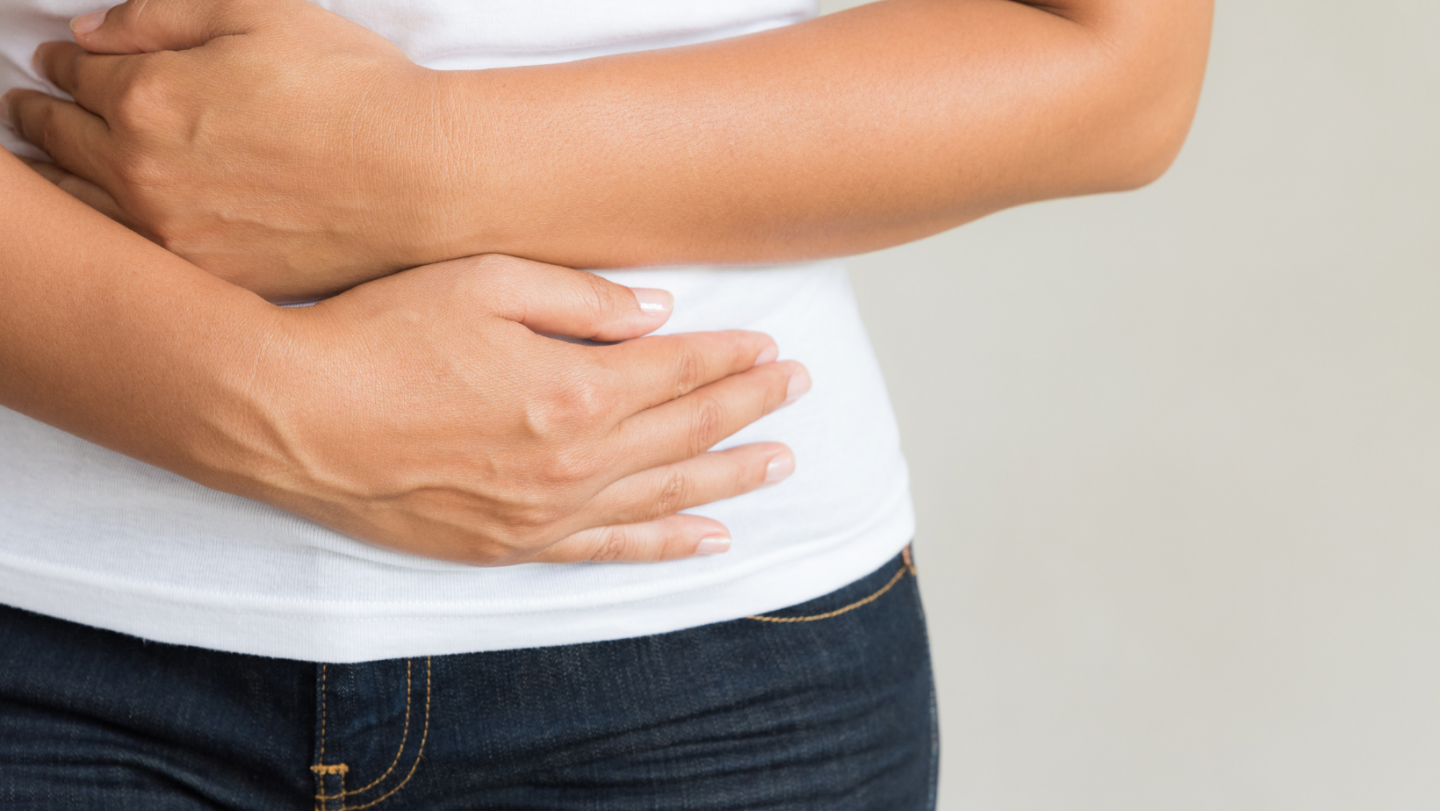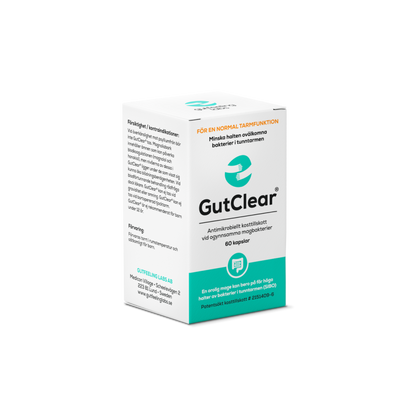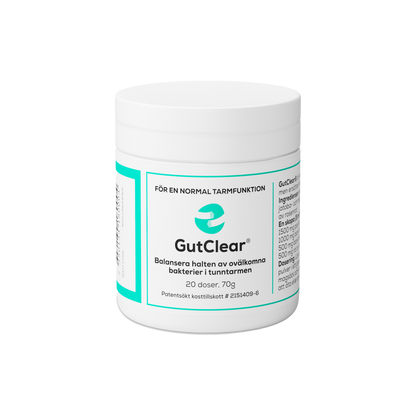Hur mag- och tarmkanalen fungerar
Innan vi går in på varför man kan få en svullen mage efter maten måste vi förklara hur mag- och tarmkanalen fungerar (under normala förhållanden).
Magsäckens viktigaste funktion är att bryta ned proteiner med hjälp av ett enzym, samt sterilisera maten med hjälp av saltsyran. Tillsammans omvandlar dessa ämnen maten till en i princip bakteriefri välling som därefter töms ned i tolvfingertarmen. I tolvfingertarmen blandas vällingen med andra enzymer från bukspottkörteln som hjälper till att bryta ned fett, kolhydrater, protein och DNA, men även med galla från levern som finfördelar fettet till mikroskopiska droppar, allt för att näringsämnena ska kunna tas upp i tunntarmen. I tunntarmens vägg finns även laktas, som bryter ned mjölksocker. Tunntarmens slemhinna är gjord för att kunna ta upp näringsämnen från tarminnehållet och dess veckade yta är ungefär lika stor som ytan på en badmintonbana. Kostfibrer som inte brutits ned av amylas från bukspottkörteln fortsätter genom tunntarmen till tjocktarmen. I tjocktarmen finns ett stort antal bakterier som kan bryta ned dessa kostfibrer. Vid denna nedbrytning bildas gas (framför allt koldioxid, vätgas och metan) och biprodukter. Tjocktarmens slemhinna är väl anpassad till att hantera produkterna från bakteriernas metabolism. I tjocktarmen tas vatten, salter och även välgörande kortkedjiga fettsyror som smörsyra och propionsyra upp till blodbanan. Tjocktarmen tar även upp vitamin K som spelar en viktig roll för blodkoagulationen.
Därför kan magen bli svullen efter mat
Det som orsakar en svullen mage efter mat är naturligtvis gas och som vi nu vet så produceras gas under normala förhållanden av bakterier i tjocktarmen. Det tar 3-4 timmar för magsäcken att tömmas och ytterligare 3-7 timmar för maten att passera genom tunntarmen till tjocktarmen. Det innebär att gasproduktionen i tjocktarmen kan ske 6-11 timmar efter måltid, det vill säga när tarminnehållet nått dit. Det finns alltså en anledning till att gasen ska produceras i tjocktarmen eftersom ändtarmsöppningen ligger i anslutning till tjocktarmen och kan släppa ut dessa gaser. Mat som kan ge näring till tarmbakterier och skapa stor gasproduktion är kost som innehåller kostfibrer av olika sorter, exempelvis fibern inulin.
Mat som innehåller inulin är:
- Lök
- Purjolök
- Vitlök
- Jordärtskockor
- Sparris
Annan mat som innehåller kostfibrer som ger gaser är:
- Äpplen
- Päron
- Björnbär
- Körsbär
- Aprikoser
- Dadlar
- Fikon
- Torkad frukt
- Vattenmelon
- Blomkål
- Broccoli
- Vitkål
- Sparris
- Kronärtskocka
- Kikärtor
- Kidneybönor
- Linser
- Röda bönor
- Sojabönor
Om det nu tar 6-11 timmar för kostfibrerna att nå tjocktarmen och brytas ned av bakterierna där, bland annat till gas, hur kan det då komma sig att man kan få problem med en uppspänd, gasig och svullen mage redan 3-4 timmar efter måltid, det vill säga när maten endast har nått tunntarmen?
Svullen mage efter mat beror på bakterier i tunntarmen
Att man får svullen mage efter mat beror ofta på en bakteriell överväxt i tunntarmen, även kallat SIBO. SIBO kan bland annat orsakas av stress och när den närings- och kostfiberrika “vällingen” från tolvfingertarmen når dessa bakterier redan i tunntarmen så börjar gasproduktionen där istället för i tjocktarmen. Eftersom gasen inte har någon utväg i tunntarmen kan tunntarmen kraftigt blåsas upp. Tunntarmens vägg är byggd för att vara genomsläpplig för näringsämnen, men även gaser kan passera genom slemhinnan och ut i blodbanan för att sedan evakueras via lungorna. Att du blir svullen om magen efter mat beror alltså på gaser i tunntarmen.

Vad kan man göra åt en svullen mage?
Måste man gå runt med en svullen mage efter maten, eller kan man bli av med problemet?
Här är några tips:
- Ta GutClear® i 10 dagar. Många tror att man ska äta mer fibrer, då fibrer är bra för magen. Men har du SIBO så hjälper det inte att öka intaget av kostfibrer, polyfenoler eller andra prebiotiska produkter. Anledningen till det beror på att detta innebär ökad näringstillförsel till bakterierna i tunntarmen och därigenom ökade gaser från bakteriernas tillväxt där. Börja istället med att få ned nivåerna av bakterier i tunntarmen med GutClear. GutClear rensar tunntarmen på bakterier.
- Undvik kostfibrer. Low-FODMAP kan hjälpa genom att reducera tillförseln av kostfibrer till bakterierna och därigenom resultera i minskad produktion av gas.
- Mindfulness: försök att göra saker och ting på ett lugnt och ordna sätt.
- Utöva yoga och meditation
- Djupandas då och då under dagen.
- Låt tunntarmen tömmas på innehåll genom att undvika att äta mellan måltiderna. Låt tunntarmen vila lite.
Blir du inte av med dina besvär ska du självklart söka hjälp av din läkare. Ingen ska behöva gå runt med en öm och svullen mage efter måltiderna. Vi hoppas dock att våra tips kan hjälpa dig och underlätta din vardag.


